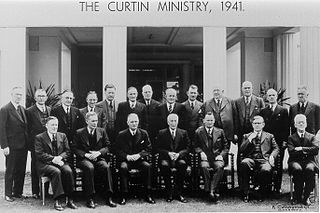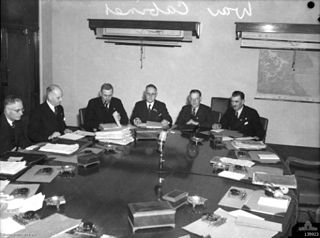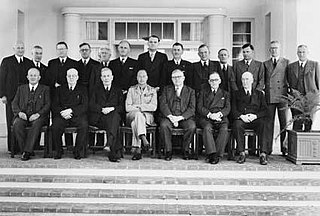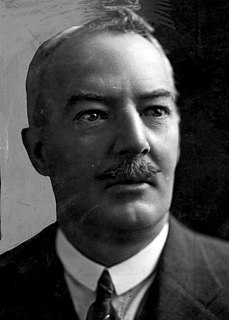
Joseph Benedict Chifley was an Australian politician who served as the 16th prime minister of Australia from 1945 to 1949. He held office as the leader of the Australian Labor Party (ALP).

Francis Michael Forde was an Australian politician who served as prime minister of Australia from 6 to 13 July 1945. He was the deputy leader of the Australian Labor Party (ALP) from 1932 to 1946. He served as prime minister in a caretaker capacity after the death of John Curtin, and is the shortest-serving prime minister in Australia's history.

The Scullin Ministry (Labor) was the 19th ministry of the Government of Australia. It was led by the country's 9th Prime Minister, James Scullin. The Scullin Ministry succeeded the Third Bruce Ministry, which dissolved on 22 October 1929 following the federal election that took place on 12 October which saw Labor defeat Stanley Bruce's Nationalist–Country Coalition. The ministry was replaced by the First Lyons Ministry on 6 January 1932 following the federal election that took place in December which saw the United Australia Party defeat Labor. As of 2020, it remains the most recent government to have lost an election after a single term in office.

The First Curtin Ministry (Labor) was the 29th ministry of the Government of Australia. It was led by the country's 14th Prime Minister, John Curtin. The First Curtin Ministry succeeded the Fadden Ministry, which dissolved on 7 October 1941 after the independent crossbenchers Alexander Wilson and Arthur Coles withdrew their support for the Fadden Government. The ministry was replaced by the Second Curtin Ministry on 21 September 1943 following the 1943 federal election.

The Second Curtin Ministry (Labor) was the 30th ministry of the Government of Australia. It was led by the country's 14th Prime Minister, John Curtin. The Second Curtin Ministry succeeded the First Curtin Ministry, which dissolved on 21 September 1943 following the federal election that took place in August. The ministry was replaced by the Forde Ministry on 6 July 1945 following the death of Curtin - the second of three occasions where a sitting Prime Minister died in office.
The Forde Ministry (Labor) was the 31st ministry of the Government of Australia. It was led by the country's 15th Prime Minister, Frank Forde. The Forde Ministry succeeded the Second Curtin Ministry, which dissolved on 6 July 1945 following the death of former Prime Minister John Curtin - the second of three occasions where a sitting Prime Minister died in office. Since Forde was the deputy Labor leader, it was a caretaker ministry until the Labor caucus could elect a new leader. Treasurer Ben Chifley was ultimately elected over Forde on 12 July 1945, and he was sworn in as Prime Minister along with his ministry the following day.

The Second Chifley Ministry (Labor) was the 33rd ministry of the Government of Australia. It was led by the country's 16th Prime Minister, Ben Chifley. The Second Chifley Ministry succeeded the First Chifley Ministry, which dissolved on 1 November 1946 following the federal election that took place in September. The ministry was replaced by the Fourth Menzies Ministry on 19 December 1949 following the federal election that took place on 10 December which saw the Liberal–Country Coalition defeat Labor.

The Fourth Menzies Ministry was the 34th ministry of the Government of Australia. It was led by the country's 12th Prime Minister, Robert Menzies. The Fourth Menzies Ministry succeeded the Second Chifley Ministry, which dissolved on 19 December 1949 following the federal election that took place on 10 December which saw the Coalition defeat Ben Chifley's Labor Party. The ministry was replaced by the Fifth Menzies Ministry on 11 May 1951 following the 1951 federal election.

Edward James "Jack" Holloway was an Australian politician who served in the House of Representatives from 1929 to 1951, representing the Labor Party. He served as a government minister under James Scullin, John Curtin, Frank Forde, and Ben Chifley.

John Ignatius Armstrong AC was an Australian politician and diplomat. He served as a Senator for New South Wales from 1938 to 1962, representing the Labor Party, and was a minister in the Chifley Government. Armstrong later served as Lord Mayor of Sydney from 1965 to 1967, and then as High Commissioner to the United Kingdom from 1973 to 1974.

Norman John Oswald Makin AO was an Australian politician and diplomat. He was an Australian Labor Party member of the Australian House of Representatives from 1919 to 1946 for Hindmarsh, from 1954 to 1955 for Sturt, and from 1955 to 1963 for Bonython. He was Speaker of the Australian House of Representatives from 1929 to 1932 and served as Minister for the Navy, Minister for Munitions (1941–1946) and Minister for Aircraft Production (1945–1946) under John Curtin, Frank Forde and Ben Chifley. He was the first President of the United Nations Security Council in 1946, and served as Ambassador to the United States from 1946 to 1951.

William James Scully was an Australian politician and farmer. He was a member of the Australian Labor Party (ALP) and held ministerial office in the governments of John Curtin and Ben Chifley, serving as Minister for Commerce (1941–1942), Commerce and Agriculture (1942–1946) and Vice-President of the Executive Council (1946–1949). He served in the House of Representatives from 1937 to 1949, representing the New South Wales seat of Gwydir.

Hubert Peter Lazzarini was an Australian politician. He was a member of the Australian Labor Party (ALP) and represented the Division of Werriwa in the House of Representatives for over 30 years. After the ALP split of 1931 he joined the Lang Labor faction, which was reunited with the official ALP in 1936. In the 1940s Lazzarini held ministerial office in the Curtin and Chifley Governments, serving as Minister for Home Security (1941–1946), Works (1945), and Works and Housing (1945–1946). Bert's great-great-great-grandneice is Courtney Houssos who is a member of the New South Wales Legislative Council.

Herbert Claude Barnard was an Australian politician. He was a member of the Australian Labor Party (ALP) and represented the Division of Bass in federal parliament from 1934 to 1949. He served as Minister for Repatriation in the Chifley Government from 1946 to 1949. His son Lance Barnard also entered federal politics and served as Deputy Prime Minister of Australia in the 1970s.

Although most Australian civilians lived far from the front line, the Australian home front during World War II played a significant role in the Allied victory and led to permanent changes to Australian society.

The Chifley government was the federal executive government of Australia led by Prime Minister Ben Chifley. It was made up of members of the Australian Labor Party in the Australian Parliament from 1945 to 1949.

The Curtin government was the federal executive government of Australia led by Prime Minister John Curtin. It was made up of members of the Australian Labor Party in the Australian Parliament from 1941 to 1945.
Labour government or Labor government may refer to:

The Australian Labor Party held a leadership election on 12 July 1945, following the death of Prime Minister John Curtin. Treasurer Ben Chifley won an absolute majority on the first ballot, defeating three other candidates: deputy leader and interim prime minister Frank Forde, navy minister Norman Makin, and attorney-general H. V. Evatt.
This page details numerous records and characteristics of individuals who have held the office of Prime Minister of Australia.







































